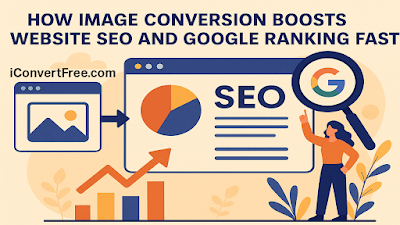In today’s competitive digital landscape, boosting your website SEO and improving your Google ranking are essential for attracting more visitors and growing your online presence. One powerful yet often overlooked strategy is image conversion — converting your website images into optimized formats that load faster and improve user experience.
In this article, we’ll explain how image conversion boosts website SEO and Google ranking fast, while answering the most common questions about image SEO to help you get maximum results.
 |
| How Image Conversion Boosts Website SEO and Google Ranking Fast |
Why Are Images Crucial for Website SEO? 🖼️
Images play a vital role in SEO by making your website more engaging and easier to navigate. Optimized images:
- Help keep visitors on your site longer, reducing bounce rates.
- Allow search engines to better understand your content through descriptive alt text and file names.
- Improve your website’s loading speed, a key ranking factor for Google.
- Increase your visibility on Google Image Search, driving additional organic traffic.
How Image Conversion Boosts Website SEO and Google Ranking ⚡
When images are large or in inefficient formats, they slow down page loading speed, harming user experience and lowering your SEO ranking. Image conversion helps by:
- Compressing images without losing quality, making pages load faster.
- Converting to modern formats like WebP which reduce file size up to 30% compared to JPEG or PNG.
- Enhancing mobile performance, critical as mobile searches dominate.
- Lowering bounce rates and increasing time spent on site, signals Google uses to rank pages.
Which Image Formats Are Best for SEO? 📷
Choosing the right image format is key to maximizing SEO benefits:
- WebP: Best for SEO due to superior compression and quality, supported by most browsers.
- JPEG: Great for photos, balancing quality and file size.
- PNG: Useful for transparent images but larger in size.
- SVG: Ideal for logos and icons, scalable with tiny file sizes.
Converting your images to these formats with tools like iConvertFree can significantly improve your SEO.
How to Convert Images for SEO Using iConvertFree 🛠️
Optimizing your images is simple:
- Upload your original image to the tool.
- Choose the optimal format (WebP, JPEG, etc.).
- Download and replace images on your site with the optimized versions.
This process boosts your website’s speed and SEO ranking fast.
Are Image Titles and Descriptions Important for SEO? 🏷️
While image titles provide context and improve accessibility, alt text is the most important for SEO. Alt text helps search engines understand your images, especially if they fail to load. Adding detailed descriptions or captions further improves SEO by providing context and relevance.
What Are the SEO Benefits of Image Optimization? 🎯
- Faster loading times: Improve user experience and Google rankings.
- Better mobile performance: Essential for mobile-first indexing.
- Increased engagement: Visitors stay longer and explore more pages.
- Improved crawlability: Search engines can index your pages efficiently.
- Reduced bandwidth usage: Lower hosting costs and faster delivery.
How Do Images Improve SEO Beyond Speed? 🔍
Images also:
- Make content more appealing and easier to understand.
- Provide opportunities to target keywords via alt text and file names.
- Help your site rank in Google Image Search results, adding another traffic source.
How to Improve Website SEO Ranking with Image Conversion? 📈
To boost your SEO ranking:
- Convert images to optimized formats like WebP.
- Use descriptive, keyword-rich file names and alt text.
- Compress and resize images appropriately.
- Combine optimized images with quality, relevant content.
How to Check Your Website’s SEO Ranking? ✅
Monitor your progress with tools like:
- Google Search Console for keyword rankings and indexing.
- Ahrefs, SEMrush, or Moz for detailed SEO analytics.
- Google PageSpeed Insights to identify image-related speed issues.
- Regular SEO audits to track improvements.
Conclusion
Optimizing your images by converting them into modern, efficient formats like WebP, adding proper alt text, and compressing them significantly boosts your website SEO and Google ranking fast. Faster load times, improved user experience, and better search engine crawlability make image conversion an essential SEO tactic.
Start using tools like iConvertFree today to enhance your website’s performance, attract more visitors, and climb Google’s search results quickly.

